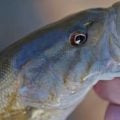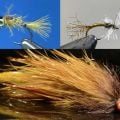Mora National Fish Hatchery’s 2016 Gila Trout Spawning Season Ends on High Note
The Mora National Fish Hatchery reports a successful year for the 2016 spawning of Gila trout, with an increase in stocking planned. “Fishery managers in New Mexico and Arizona have identified 20 streams suitable for Gila trout stocking this year. This is up from nine water bodies from last year,” says hatchery manager Nathan Wiese.
Read more in the press release below.
Mora National Fish Hatchery’s 2016 Gila Trout Spawning Season Ends on High Note
Mora National Fish Hatchery’s Gila trout spawning season has ended in 2016 on a high note. The Federal facility spawned 560 captive and wild pairs of Gila trout yielding 122,423 eyed-eggs. Given the expected high survival rate in the hatchery, the eggs should result in nearly 80,000 young trout that will be stocked in the wild in autumn, reaching five inches at stocking time. More than 10,000 Gila trout have already been stocked in 2016 into waters of the Gila National Forest.
“It’s been great going at Mora,” said hatchery manager, Nathan Wiese. “We expect to double the number of Gila trout this year over what we stocked in 2015. Fishery managers in New Mexico and Arizona have identified 20 streams suitable for Gila trout stocking this year. This is up from nine water bodies from last year.”
Of the expected 70,950 young trout, 18,825 will go to Arizona waters, and 52,125 will be stocked in New Mexico. Many of the trout will be placed in streams closed to fishing at present so as to help bolster the fish’s conservation status. Those trout produced this year in excess of that needed for recovery purposes will be placed in waters open to fishing.
The Gila trout is considered a threatened species under the Endangered Species Act, and occurs naturally only in the headwaters of the Gila River system of New Mexico and Arizona. The trout had been closed to fishing for more than 50 years. Conservation work by the New Mexico Department of Game and Fish; Arizona Game and Fish Department; U.S. Forest Service; U.S. Fish and Wildlife Service; Trout Unlimited; University of New Mexico, and the helping hands of dedicated citizen-conservationists improved the status of the rare trout. It was the Nation’s only endangered trout until 2006. Gila trout populations were opened to angling in 2007.
That year also marked the first stocking of Gila trout when Mora National Fish Hatchery produced a comparatively small 3,024 trout. Today’s successes come from past experience notes the hatchery’s manager. “The Gila trout is not an easy species to raise,” said Wiese. “It’s one of the rarest trout species in the world and we have had to learn as we go. Our successes now are built on what we have learned from the past.”
This rare trout consists of five distinct populations coinciding with five distinct and widely separated headwater streams in the Gila National Forest. The hatchery holds Gila trout from each population in captivity. Each population is intensively managed in the hatchery to preserve robust genetics unique to each stream.
“Mora is not your run-of-the-mill hatchery,” said Wiese. “Gila trout in a hatchery is akin to captive-rearing other highly imperiled organisms. The hatchery is a safeguard—and it’s a jumpstart—while habitat restoration is underway. The quality of the trout matter most, ensuring as best we can that the imprint of nature remains in the genes of these trout. It’s a great time to be a Gila trout angler.”
Mora National Fish Hatchery is one of 70 national fish hatcheries located across the country. The facility is entirely indoors and operates with a state-of-the-art water circulation system. The hatchery also holds a small population of endangered bontyail, a fish found naturally only in the Colorado River system. The hatchery is open to visitors. Contact: Nathan Wiese at (575) 387-6022.
The mission of the U.S. Fish and Wildlife Service is working with others to conserve, protect and enhance fish, wildlife, plants and their habitats for the continuing benefit of the American people. We are both a leader and trusted partner in fish and wildlife conservation, known for our scientific excellence, stewardship of lands and natural resources, dedicated professionals, and commitment to public service. For more information on our work and the people who make it happen, visit www.fws.gov/southwest/
Contacts:
Nathan Wiese (505) 387-6022 Nathan_Wiese@fws.gov
Craig Springer (505) 248-6867 craig_springer@fws.gov
Tippets: Reconnecting Rivers, Lake Michigan’s King Salmon, How Dams are Removed, Young Fish and Microbeads
Tippets: Deep Sea Bioluminescence, Fighting Atlantic Salmon Farms, Herring Return to Hudson River Tributary, Farmed Salmon Hearing Loss













